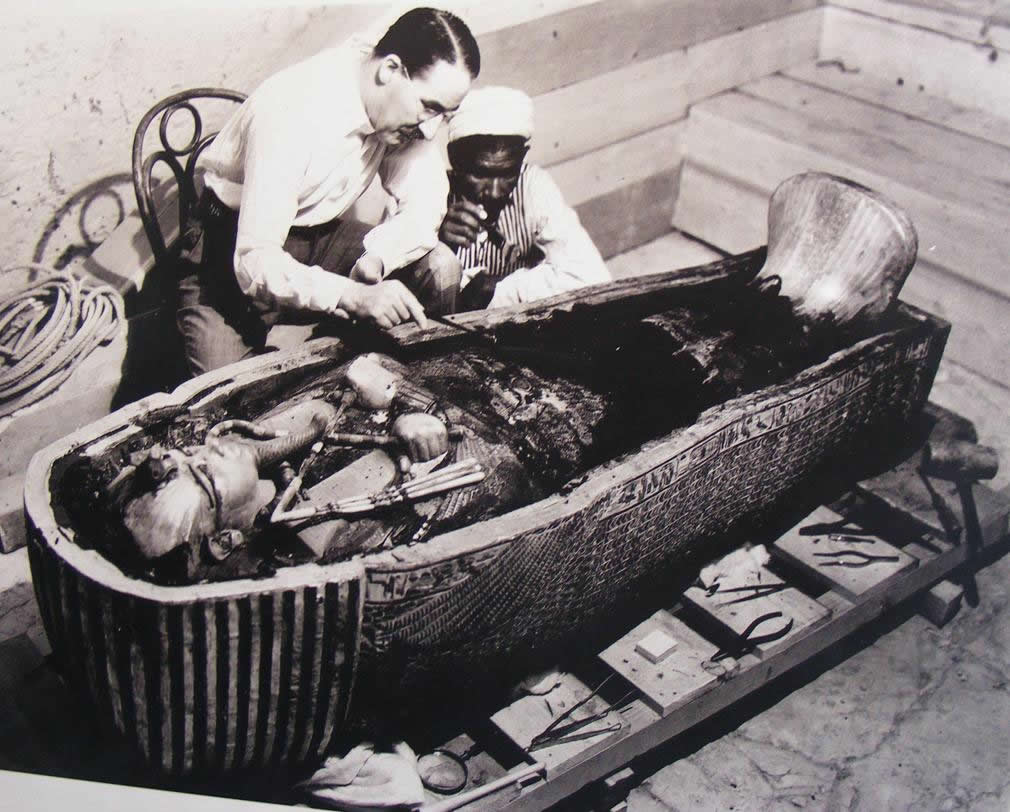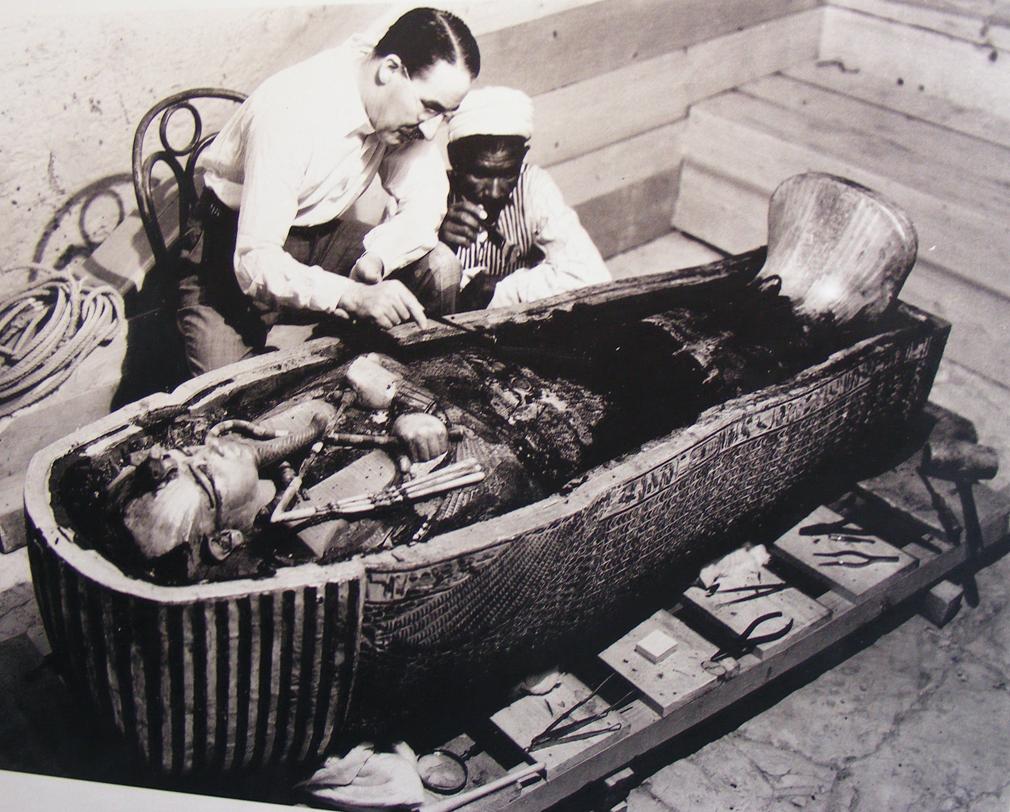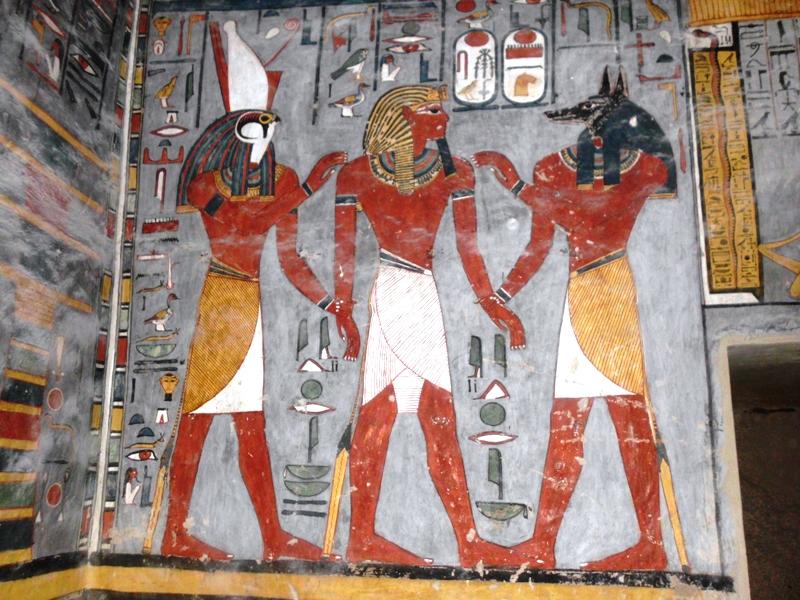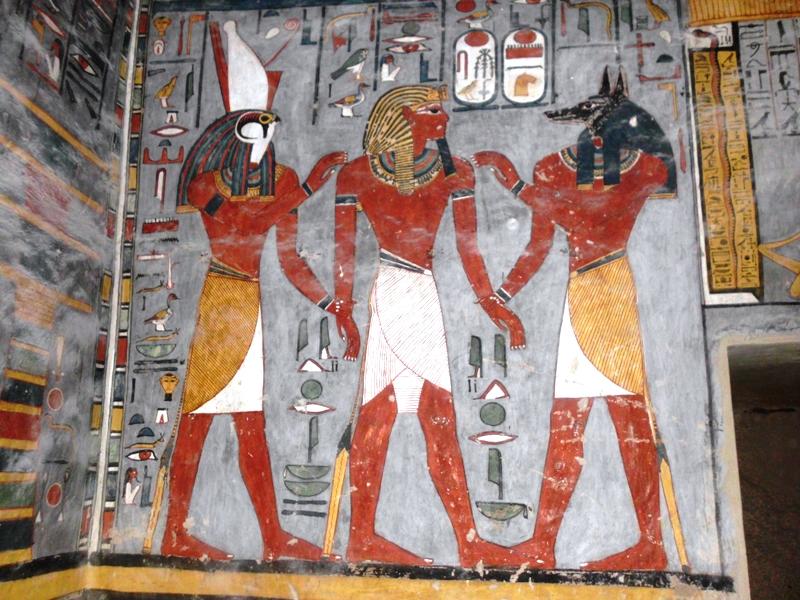|
|

| |
| |
The Pyramid Complex of Djoser
|
| |
The great burial district of King Djoser forms the
lonely peak in the development of the royal burial sites
of the early 3rd millennium B.C., which combine elements
of the Upper and Lowers Egyptian traditions.
The various structures around the pyramid were the first
sacral building in stone, and they offered the deceased
pharaoh lasting proof of his life after death.
With the exception of his tomb and the mortuary temple,
which was the burial place and cult center, the other
buildings were executed as fašades only; they define
their function but are not incorporated in any concrete
sequences of action.
This concept of a residence in the afterlife that would
be used for eternity evolved in several buildings phases
like the pyramid itself, it was not and inspired
original design by Imhotep, although as site manager he
directed most of the project.
It was only later that he was seen as the inventor of
building in dressed stone, a wise man who came to be
revered as a god. Despite intensive efforts the search
for Imhotep’s tomb, which was certainly located to the
north of the Step Pyramid, has so far been unsuccessful.
Not only was the achievement of Djoser’s brilliant
official to live in the minds of those who came after
him for thousands of years, the building itself was
regarded as particularly admirable in the late period.
The reliefs in the false door niches of the south tomb,
for example, served as models for similar scenes in the
Palace of King Apries (Twenty- sixth Dynasty) at
Memphis.
|
| |
| |
The Step Pyramid |
|
| |
The Step Pyramid of King
Djoser was the first monumental building in stone in the
history of mankind. It stands on the northern end of the
great court.
Originally the tomb was intended to be a huge mastaba in
stone, but it then underwent several extensions. Only
later was the building changed into a structure in four
steps; these were then extended again until the
pyramidal from was finally reached in the sixth stage,
at a height of nearly 200 feet (60 m).
The pyramid is built of relatively small blocks of stone
and these were then covered in Tura limestone, while the
stepped structure was retained.
The entrance to the tomb of King Djoser is on the north
side, near the mortuary temple, where the small chamber
of status (Serdab) containing the celebrated seated
figure of the king was revealed.
The subterranean chambers (down to a depth of 100 feet
or 32 m), including the burial chamber of the king of
red granite, are labyrinthine; the storerooms alone held
ten thousands of stone vessels.
|
 
|
| |
| |
| |
The Great Enclosure Wall |
|
| |
The entire areal of the
pyramid (1771 x 900 ft or 545 x 287 m) is enclosed by a
mightily wall built of blocks of limestone and
subdivided by niches.
It is 32 ft (10.5 m) high and also subdivided by 14 false gateways; the
only real entrance is in the south east corner.
This gateway leads into a long colonnade that was once
roofed; ribbed engaged columns were used here, imitating
bundles of reeds.
The roof beams in the entrance corridor and a wing of
the door that has been opened, as well as a roof tile,
illustrate the principle of blind and “dummy”
architecture, for the earlier models in wood have been
translated into the new material, stone here.
|
 
|
| |
| |
The Palace of the South |
|
| |
To the east of the
pyramid stand two false buildings each with its own
court.
They are known as the “Palace of the South” and the
“Palace of the North” and they represent the idea of the
dualism of Egypt.
Their external form is modeled on the cult chapels of
prehistoric times.
The fašades are covered with four slender fluted half-
columns, the inside two of which flank the entrance. The
entrance zone of the “Palace of the South” has been
reconstructed and it has a decorative band directly
above the door with pointed elements known as the “Kheker
frieze”.
|
 
|
| |
| |
The Heb-Sed Court |
|
| |
The small Heb- Sed
courtyard is one of the finest individual sites in the
cult precinct.
Originally it was accessible down a long passage leading
from the entrance.
In its present form the court and the chapels flanking
it are the life’s work of the French archaeologist Jean-
Philippe Lauer, who has been studying the Djoser complex
since the 1930s and is directing the reconstruction
work.
His findings have greatly furthered our knowledge and understanding of
these buildings, which bear no relief decorations or
inscriptions that, might assist their interpretation.
In their two different basic types the chapels, that are
in blind (or “dummy”) architecture, are modeled on the
canonical shrines of upper and Lower Egypt.
Together here as regional shrines of the gods they
symbolize the entire country, and so offer the deceased
pharaoh a kind of cult stage for the eternal celebration
of his jubilee as ruler (Egyptian “Heb-Sed”).
However, the rites of the Sed festival were actually
preformed in the King’s palace in Memphis. Unfortunately
nothing is known about these facilities.
|
 
|
| |
| |
The South Tomb |
|
| |
The south Tomb, named
after its position in the burial compound, is in the
shape of a mastaba with a vaulted roof. On the court
side it has an extension, the outer wall of which is
subdivided by shallow niches, while the top is crowned
with a magnificent frieze of uraeae.
The function of this second tomb was a subject of
controversy for a long time, but it is probably right to
see it as the mythical burial place required for the Sed
festival and indented for the regeneration of the ruler.
Together with the great court before the pyramid, which
if the fictive location of the cult ceremonies and the
small Heb- Sed court with its chapels for the gods, the
South tomb was one of the essential structures in this
major royal festival
|
 
|
| |
| |
King Djoser performing the
Sed-festival |
|
| |
Like the genuine tomb of
King Djoser under his pyramid the South Tomb also has a
burial chamber in red granite; it lies at the foot of a
deep shaft.
As in the actual tomb some of the surrounding chambers
were given particular prominence by covering the walls
with small turquoise faience tiles.
These little vertical tiles were attached to the wall
with mortar between stone strips.
They were additionally held in place with a thin string
made of vegetable fibers that ran through little eyes on
the back of the tiles.
The carpet-patterned structure of the walls which this
created in this palace of eternity is interrupted by
niches designed like false doors with raised reliefs on
their rear walls.
The depictions show king Djoser performing the carious
ceremonies in the Sed festival, although it remain an
open question whether the ruler ever actually had to
perform this ritual.
But the image remained in use right down to Greek and
Roman times as a highly effective symbol of the physical
power of the pharaoh.
On the outer frame of the niches the King’s titles are
inscribed.
The name of Djoser was not used in his own time, he was
known by his Horus-name as Netjeri-Khet (“divine in
body”).
|
 
|
| |
| |
 |
The
Pyramid of Cheops
The largest
pyramid ever built in Egypt was known as the horizon
of Cheops. This is building, astonishing in the
precision of its execution |
 |
|
|
|
 |
The Pyramid of Chephren
king Chephren
had his pyramid built in Giza at a diagonal angle to
the building erected by Cheops. |
 |
|
|
 |
The Pyramid of Mycerinus
The modest
height of the pyramid of Mycerinus, which formerly
reached 216 ft (66 m), may have been a country... |
 |
|
| |
 |
The
Great Sphinx
The figure of
the great Sphinx was worked from a rocky out crop.
The colossal sculpture (240 x 65 ft; 73.5 x 20 m) |
 |
|
| |
 |
The Solar Barque of Cheops
In 1954, yet
another sensational find was in the necropolis area
of Giza, already far from lacking in major
discoveries. While work was in progress directly in
front of the south side of the pyramid of Cheops. |
 |
|
| |
 |
Egyptian Museum
The first
Egyptian Museum of Pharaonic antiquities was
established in 1863 by the famous French
archeologist, Auguste Mariette. Afterwards, because
of the many Pharaonic treasurers discovered in Egypt
. |
 |
|
| |
 |
Memphis
The present
situation of the ancient capital of Egypt could
hardly be put more cogently, for very little of the
former glory of the metropolis remains. A few
colossal royal statues, the great alabaster sphinx. |
 |
|
| |
 |
Saqqara
Beside the
cemetery area of the western Thebes, Saqqara is the
most extensive mortuary town in Egypt, and it is
known to have been used from the early Dynastic
period (First / Second Dynasties) |
 |
|
| |
 |
The Pyramid Complex of Djoser
The great
burial district of King Djoser forms the lonely peak
in the development of the royal burial sites of the
early 3rd millennium B.C. which combine elements of
the upper Egypt and lower Egyptian traditions. |
 |
|
| |
 |
Dahshur
Only a few
miles south of Saqqara stretches the important and
extensive pyramid field of Dahshur (opened to the
public 1996). Immediately on the edge of the fertile
land lie the brick buildings of tree rules of the
Twelfth Dynasty. |
 |
|
| |
 |
The
Coptic Museum
The Coptic museum,
founded in 1908 by Marcus Simaika Pasha, contains
the largest collection of Coptic monuments in the
world. |
 |
|
| |
 |
The el-Moallaqa Church
The church of
the Virgin Mary was constructed above the two 59-ft
(18-m) towers of the southern gateway of the
fortress of Babylon |
 |
|
| |
 |
Jewish Monuments
The Moses Ben
Maimon synagogue is an important historical and
religious monument in Egypt, and its restoration
will return a piece of Jewish heritage to Egypt. |
 |
|
| |
 |
Al-Azhar Mosque
No other mosque
in Cairo surpasses Al-Azhar , "The Flowering," in
tradition and importance. Soon after its foundation
in 970 A.D. it became the site of university
studies, which continued there to the present. |
 |
|
| |
 |
Ibn Tulun Mosque
Cairo owns one
of its oldest and most beautiful mosques to Ahmed
Ibn Tulun, founder of the short lived Tulunid
dynasty. |
 |
|
| |
 |
Mosque of Sultan Hasan
The mosque
built below the citadel by Sultan Hasan 91347-1361)
is among the outstanding achievements of Islamic
architecture. |
 |
|
| |
|
|
|
|
|
|
|
|
|